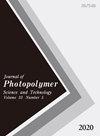Orientation Control of the Microphase-separated Nanostructures of Block Copolymers on Polyimide Substrates
IF 0.7
4区 化学
Q4 POLYMER SCIENCE
Journal of Photopolymer Science and Technology
Pub Date : 2021-06-11
DOI:10.2494/photopolymer.34.439
引用次数: 0
Abstract
This study aimed to form a perpendicularly orientated lamellar structure with polystyrene-block -poly(methyl methacrylate) (PS- b -PMMA) by its microphase separation on a polyimide substrate. Eight types of polyimides were prepared from different combinations of monomers and tested as the bottom layer for the microphase separation of PS- b -PMMA. The surface free energies of those polyimide substrates were evaluated by the Owens-Wendt method. Thin films of PS- b -PMMA were prepared on the polyimide substrates and the self-assembly was induced by thermal annealing, and the surface architecture was observed by atomic force microscopy. In the tested polyimide substrates, only one from 2,2-bis[4-(3,4-dicarboxyphenoxy) phenyl]propane dianhydride (tetracarboxylic dianhydride) and 1,12-bis (4-aminophenoxy) dodecane (diamine) showed a perpendicularly oriented lamellar structure. This polyimide substrate shows one of the smallest polar components in its surface free energy. Relatively large domain size and long correlation length in the PS- b -PMMA layer were obtained by optimizing the conditions for fabrication of the polyimide substrate, which were prepared by casting the polyimide onto a silicon wafer, followed by thermal annealing. These results suggest that the combination of one monomer with relatively large molecular weight, which will result in a low density of imide groups, and the other monomer with long alkyl chains, which will reduce the polarity of the resulting polyimide, contributes to providing a perpendicular orientation.聚酰亚胺基嵌段共聚物微相分离纳米结构的取向控制
本研究旨在利用聚苯乙烯-嵌段聚甲基丙烯酸甲酯(PS- b - pmma)在聚酰亚胺基底上的微相分离形成垂直取向的层状结构。以不同的单体组合制备了8种不同类型的聚酰亚胺,并对其作为微相分离PS- b - pmma的底层进行了测试。用Owens-Wendt法计算了这些聚酰亚胺衬底的表面自由能。在聚酰亚胺基底上制备了PS- b - pmma薄膜,通过热退火诱导其自组装,并用原子力显微镜观察其表面结构。在测试的聚酰亚胺底物中,只有2,2-二[4-(3,4-二氧基苯氧基)苯基]丙烷二酐(四羧基二酐)和1,12-二(4-氨基苯氧基)十二烷(二胺)表现出垂直取向的层状结构。这种聚酰亚胺衬底在其表面自由能中显示出最小的极性组分之一。通过优化聚酰亚胺衬底的制备条件,将聚酰亚胺浇铸在硅片上,然后进行热处理,得到了较大的畴尺寸和较长的相关长度。这些结果表明,一个相对较大分子量的单体的组合将导致亚胺基团的密度低,而另一个具有长烷基链的单体的组合将降低所得聚酰亚胺的极性,有助于提供垂直取向。
本文章由计算机程序翻译,如有差异,请以英文原文为准。
求助全文
约1分钟内获得全文
求助全文
来源期刊
CiteScore
1.50
自引率
25.00%
发文量
0
审稿时长
4-8 weeks
期刊介绍:
Journal of Photopolymer Science and Technology is devoted to the publication of articles on the scientific progress and the technical development of photopolymers.

 求助内容:
求助内容: 应助结果提醒方式:
应助结果提醒方式:


